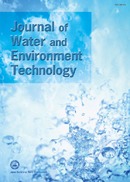
- 6 号 p. 199-
- 5 号 p. 163-
- 4 号 p. 129-
- 3 号 p. 77-
- 2 号 p. 35-
- 1 号 p. 1-
- |<
- <
- 1
- >
- >|
-
Yasukazu Kobayashi, Ryo Kanasaki, Takuya Nozaki, Ryo Shoji, Kazunori S ...原稿種別: Original Article
2017 年15 巻2 号 p. 35-42
発行日: 2017年
公開日: 2017/04/10
ジャーナル フリーRemoval of Pb (II) ions from water was carried out by a coupling approach of adsorption and photoelectrodeposition over a porous TiO2 photocatalyst loaded with MnO2. The addition of MnO2 onto the porous TiO2 accelerated the photocatalytic oxidation of Pb (II) ions, which was caused by a strong interaction between MnO2 and Pb (II) ions. Since the same effect was not observed on the photocatalytic degradation of methylene blue over MnO2/TiO2 photocatalysts, the photoelectrodeposition reaction rate appears to be determined by the amount of Pb (II) ions adsorbed on the surface of porous TiO2 loaded with MnO2.
抄録全体を表示PDF形式でダウンロード (1698K) -
Yugo Takabe, Shuji Himeno, Yuji Okayasu, Mizuhiko Minamiyama, Toshiya ...原稿種別: Original Article
2017 年15 巻2 号 p. 43-54
発行日: 2017年
公開日: 2017/04/10
ジャーナル フリーOutdoor biomass production by indigenous microalgae cultivation with treated effluent is strongly and complexly affected by fluctuating environmental conditions and water qualities in wastewater treatment plants (WWTPs), thus, mathematical models are required to discuss production performance. In this study, five-month outdoor cultivations with CO2 addition were conducted in two WWTPs (A and B) to reveal cultivation characteristics and examine the applicability of a previously developed model to different WWTPs. The limiting factor for microalgae growth in the treated effluent was different between WWTPs A (carbon) and B (phosphorus). Suspended solids (88 mg/L) in the culture at WWTP B were significantly lower than those at WWTP A (113 mg/L) due to phosphorus starvation in the culture at WWTP B. Meanwhile, Chlorophyceae dominated throughout the cultivation period at both WWTPs. The repeatability of the cultivation characteristics by the model at the same WWTP in different years was verified. It was revealed that application of the model to a new WWTP is difficult with regard to some coefficients. However, sensitivity analysis to identify the dominant coefficient affecting biomass productivity in the model and modification of the coefficient based on simple cultivation experiments resulted in the model being applicable to the new WWTP.
抄録全体を表示PDF形式でダウンロード (972K) -
Shiho Kobayashi, Satoshi Nakada, Masaki Nakajima, Keigo Yamamoto, Sato ...原稿種別: Original Article
2017 年15 巻2 号 p. 55-64
発行日: 2017年
公開日: 2017/04/10
ジャーナル フリーA study of the use of a visualization technique for the distributions of dissolved organic matter (DOM) in coastal seas was conducted to assist environmental water management. In this study, the absorption coefficient of colored dissolved organic matter (aCDOM) obtained from a satellite equipped with an ocean color sensor as an index for visualizing the DOM distributions. In 2010, the first geostationary satellite having the sensor (COMS/GOCI) was launched, enabling hourly high-resolution data (~500 m) on aCDOM to be obtained. The spatial and temporal resolutions of the data derived from this satellite are the most appropriate for investigating the water quality in coastal seas, which changes dynamically depending on weather conditions. A surface water sampling was undertaken in 2015 in Osaka Bay, Japan. The concentrations of dissolved organic carbon and nitrogen, the main components of DOM, were highly correlated with field-obtained aCDOM, (R2 = 0.91, 0.90 (n = 39), respectively). The field-obtained aCDOM was significantly correlated with the satellite-derived aCDOM (R2 = 0.60, (n = 54)). These results indicate the potential to use satellite ocean color sensors (GOCI) to visualize and assess the distribution of DOM in coastal seas at high temporal resolution.
抄録全体を表示PDF形式でダウンロード (3807K) -
Rawintra Eamrat, Yuya Tsutsumi, Tatsuru Kamei, Willawan Khanichaidecha ...原稿種別: Original Article
2017 年15 巻2 号 p. 65-75
発行日: 2017年
公開日: 2017/04/10
ジャーナル フリーNitrate contamination of groundwater has become a serious issue affecting the quality of drinking water and human health. An energy-efficient, low-cost, and simple reactor was developed to remove nitrate via hydrogenotrophic denitrification (HD). Hydrogen (H2) supply was optimized by using a continuous supply of hydrogen (1–15 mL/min). The results revealed that the optimal condition was 5 mL/min, which yielded a nitrogen removal efficiency of 86.4% and a hydrogen effectiveness of 199 mg-N/g-H2. In the subsequent experiment, an intermittent hydrogen supply was used to improve the hydrogen effectiveness and hydrogen consumption. Using a cycle with a short period of hydrogen supply (3 min with hydrogen supply and 7 min with no hydrogen supply), excellent nitrogen removal efficiency (96.5%) was achieved, and the hydrogen effectiveness increased to 744 mg-N/g-H2. Furthermore, bacteria belonging to the Proteobacteria phylum and Betaproteobacteria class were the major components of the microbial community. However, Hydrogenophaga spp. (39.3%) was dominant under the continuous system, whereas Thauera spp. (58.5%) was the most abundant species under the intermittent system. In this study, Hydrogenophaga spp., Thauera spp., and Rhodocyclaceae, which were responsible for HD, afforded in efficient nitrogen removal from groundwater.
抄録全体を表示PDF形式でダウンロード (3439K)
- |<
- <
- 1
- >
- >|